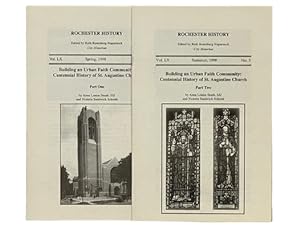Staub Anna Louise Schmitt Victoria (1 results)
Product Type
- All Product Types
- Books (1)
- Magazines & Periodicals
- Comics
- Sheet Music
- Art, Prints & Posters
- Photographs
- Maps
-
Manuscripts &
Paper Collectibles
Condition
- All Conditions
- New
- Used
Binding
- All Bindings
- Hardcover
- Softcover
Collectible Attributes
- First Edition
- Signed
- Dust Jacket
- Seller-Supplied Images
- Not Printed On Demand
Seller Location
Seller Rating
-
Building an Urban Faith Community: Centennial History of St. Augustine Church, Two Volume Set: Part I; Part II (Rochester History, Spring, 1998, Vol. LX, No. 2; Summer, 1998, Vol. LX, No. 3)
Published by Rochester Public Library, 1998
Seller: Yesterday's Muse, ABAA, ILAB, IOBA, Webster, NY, U.S.A.
Stapled Binding. Condition: Fine. A fine copy. 1998 Stapled Binding. 31; 31 pp. Two volume set. As Robert McNamara explains in his history of the Rochester diocese, Bishop McQuaid created St. Augustine as part of a larger expansion of Rochester Catholic churches. St. Augustine opened first as a wood-framed mission of St. Patrick?s Cathedral at Chili Avenue and Hobart Street in 1898, and became a full-fledged parish in 1906. The new parish reduced the distance that Irish, English, and German Catholics in southwest Rochester would have to travel to attend Mass or Catholic school. The Sisters of St. Joseph staffed St. Augustine?s school, although the first principal, Sr. M. Regina Flaherty, was soon reassigned to open St. Monica?s Catholic school. After a fire damaged the original wood-framed mission church building in the fall of 1906, Fr. John H. O?Brien, the first full-time pastor, opted to build a new facility. Architect Joseph Oberlies designed a single building consisting of both the church and its school. According to church historians Victoria Schmitt and Sr. Anna Louise Staub, SSJ, this ?duplex structure? enabled St. Augustine ?to grow, and then build a separate church. After that, the whole duplex building could be used as a school.? To mark the opening of the new church-school building, parishioners hosted a public fair. Photographs show that the church basement was filled with local vendors and American flags. The flags reflect Catholics? (especially immigrant Catholics?) attempts to overcome Progressive-Era anti-Catholicism and show that Catholics were sufficiently patriotic, despite their veneration of the Roman pope. Although tensions existed in this period between Catholics of different national origins, the institution of the Catholic parish, Schmitt and Staub note, ?provided a fortress to offset the cultural influence of the dominant Protestant community. It provided spiritual life and familiar rituals, education, an active social life, and welfare.? With that said, I disagree with Schmitt and Staub?s claim that Catholics ?sought to impress outsiders, but not necessarily ? attract or transform them.? Rather, by fusing Roman Catholic ritual with signs of democracy, American Catholics tried to claim their place in the republic and change the minds of Protestants who viewed them with suspicion. - Digitizing Rochester's Religions.


